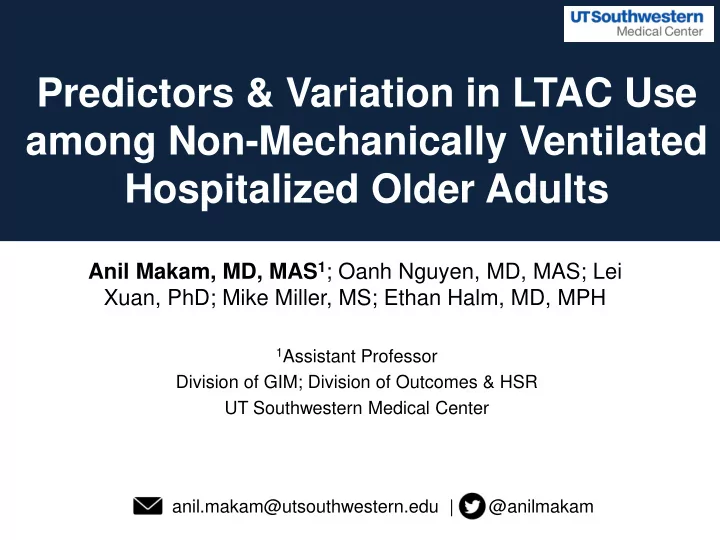

Predictors & Variation in LTAC Use among Non-Mechanically Ventilated Hospitalized Older Adults Anil Makam, MD, MAS 1 ; Oanh Nguyen, MD, MAS; Lei Xuan, PhD; Mike Miller, MS; Ethan Halm, MD, MPH 1 Assistant Professor Division of GIM; Division of Outcomes & HSR UT Southwestern Medical Center anil.makam@utsouthwestern.edu | @anilmakam
FUNDING DISCLOSURE *No conflicts of interest to disclose @AnilMakam
BACKGROUND • Long-term acute care hospitals (LTACs) specialize in caring for patients with serious & complex illness who need inpatient care for an extended period of time (3-5 weeks) • Most expensive post-acute care provider • LTACs are most effective for ventilation weaning, but fewer than 25% of LTAC patients receive prolonged mechanical ventilation @AnilMakam
KNOWLEDGE GAP • Despite providing an overlapping level of care with acute care hospitals, unclear why non- mechanically ventilated older adults are transferred to LTACs @AnilMakam
RESEARCH QUESTIONS 1. What are the patient, hospital, and region-level predictors of LTAC transfer vs staying in the acute-care hospital? 2. How much of the variation in LTAC use is explained by each of these 3 levels? @AnilMakam
METHODS • Study Design: Observational cohort study • Data: 5% national Medicare data – Hospital : CMS Provider of Services file – Regions : Dartmouth Atlas @AnilMakam
PARTICIPANTS Non-mechanically ventilated hospitalized older adults in FY2012 with continuous Medicare A&B (no part C) in prior 12 months Stay in the Hospital Prolonged hospitalization without a post-acute care Transferred to LTAC transfer, defined as having LOS ≥ average hospital LOS among those transferred to LTAC Restricted to the top 50 most common diagnoses leading to LTAC transfer (~2/3 rds of LTAC population)
ANALYSIS • Predictors: multilevel mixed effects model to account for clustering of patients in hospitals, and hospitals in regions • Variation: sequential multilevel models – Variance partition coefficients (VPCs) • Captures residual variation explained at each level – Adjusted region and hospital LTAC transfer rates • Heat map & variation profile plots – Intraclass correlation coefficient (ICC) • Assesses how similar hospitals are within regions @AnilMakam
CHARACTERISTICS LTAC Stay in Hospital N=1831 N=11,044 Age ≥85 years 24% 28% Female 55% 56% White 75% 81% Charlson index, median 5 4 Hospital LOS, median 10 12 ICU stay ≥ 3 days 50% 42% @AnilMakam
PREDICTORS Adjusted OR (95% CI) Patient* Prior LTAC stay 1.77 (1.36-2.31) Wheelchair use 1.30 (1.10-1.53) Respiratory diagnosis 0.71 (0.60-0.85) Circulatory diagnosis 0.65 (0.54-0.78) Central line 1.57 (1.34-1.83) Excisional debridement 2.05 (1.31-3.22) Hospital For-profit hospital 1.58 (1.27-1.95) Urban location 0.54 (0.39-0.73) Region* Distance to LTAC, <1.4 vs >34 miles 6.18 (4.21-9.09) Medicare spending, per $3000 1.48 (1.06-2.06) Median income, per $10,000 0.88 (0.79-0.97) *selected list
RESULTS: VARIATION VPCs Case-Mix Only Full Model Between patients 56.9% 74.5% Between hospitals 15.4% 18.4% Between regions 27.8% 7.1% • After accounting for differences in patient case-mix, differences between hospitals (15%) & regions (28%) account for nearly half of why older adults are transferred to an LTAC • Three-quarters of regional variation is explained by the region- level predictors included in the model (28% 7%) @AnilMakam
RESULTS: VARIATION VPCs Case-Mix Only Full Model Between patients 56.9% 74.5% Between hospitals 15.4% 18.4% Between regions 27.8% 7.1% • After accounting for differences in patient case-mix, differences between hospitals (15%) & regions (28%) account for nearly half of why older adults are transferred to an LTAC • Three-quarters of regional variation is explained by the region- level predictors included in the full model (28% 7%) @AnilMakam
ADJUSTED LTAC TRANSFER RATE BY REGION *Adjusted for differences in case-mix @AnilMakam
HOSPITAL VARIATION IN LTAC USE *Adjusted for patient, hospital, and region-level predictors *n=1038 hospitals with ≥5 patients % Transferred to LTAC Median = 7% (IQR, 3%-18%) Hospitals Sorted in Ascending Order of Adjusted LTAC Transfer Rate @AnilMakam
HOSPITAL CORRELATION • Hospitals within the same region are only modestly correlated (ICC 0.25) with one another with respect to LTAC use @AnilMakam
HOSPITAL VARIATION BY REGION @AnilMakam
LIMITATIONS • May have omitted important patient-level predictors of LTAC use due to use of administrative data – VPCs still robust since capture unobserved differences @AnilMakam
CONSLUSIONS • Nearly half of variation in LTAC use is unrelated to patients’ illness severity or preference • Regional differences explain over a quarter of variation, with far greater use in the South • Considerable hospital variation, even among hospitals in same regions with same LTAC access @AnilMakam
IMPLICATIONS • More than one place to recover from serious illness among non-mechanically ventilated older adults – LTAC transfer may improve care by more focus on interdisciplinary rehab, but could increase fragmentation – LTAC transfer generates a separate bundled payment, so more expensive for Medicare & ACOs • Need for comparative effectiveness research of LTAC vs hospital care for recovery & costs @AnilMakam
QUESTIONS? anil.makam@utsouthwestern.edu @anilmakam
Recommend
More recommend